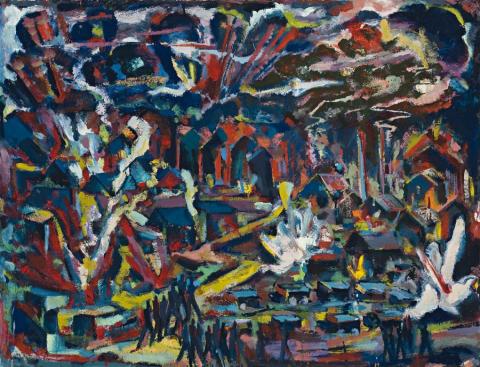WAR CONCEPTION, 1941-42
Roger Kemp
enamel on cardboard
85.0 x 110.5 cm
inscribed verso: War Conception 1942
Private collection, Melbourne
Roger Kemp: Cycles and Directions, 1935 – 1975, Exhibition Gallery, Monash University, Melbourne, 5 – 30 September 1978, cat. 30, as Exploding Forms (illus. in exhibition catalogue)
Heathcote, C., The Art of Roger Kemp, Macmillan, Melbourne, 2007, p. 58 (illus.), p. 60
Movement is the key to Roger Kemp's art, applied literally and metaphorically. In his paintings of the late 1930s it is movement inspired by music as in Landscape in Music 1939-45 or Metamorphosis 1939-42. With the outbreak of World War II, however, the mood of Kemp's paintings changed from idealistic joy to that of troubled darkness, as Christopher Heathcote described 'claustrophobic and alarmingly apocalyptic.'1 The War gave birth to many powerful icons of Australian art such as Albert Tucker's Images of Modern Evil, while Russell Drysdale's paintings and drawings of soldiers at Albury Railway Station possess a haunting grandeur. Although Kemp, like Drysdale, was not considered medically fit to serve in the armed forces, the horrors of modern warfare had a decisive impact on his art as seen in his powerfully moving War Conception 1941-42. The clash of colours, anchored in the blacks of destruction is allied with the agitation of the forms to create a deeply moving sense of apprehension. This is heightened by the overall perturbation set up by the clashes between figuration and abstraction. Lines of human figures, rows of motor vehicles, and homes and buildings emerge briefly from the conflagration only to submerge into its violence. War references are in plenty - the blitzkrieg of Armageddon from the heavens, fires of blood red, figures ordered in ranks of military style, and the exploding and imploding of the cataclysm. Kemp produced a visual metaphor of the birth of destruction and its dynamics. Movement is violence in an intentional malaise of semi-figurative expressionism; a collusion of colour and form in a dramatically moving statement about war.
In June 1945, a few years after this painting, Kemp held his first solo exhibition at the Velasquez Gallery, Melbourne. Although War Conception was not included, such paintings as Metaphysical Disturbance, Modern Hostilities in Mind Form and Formal Conception in Colour indicate they way his art was moving, allied to our painting. Clive Turnbull, writing for the Melbourne Herald, said the show 'provides the most interesting work of the year to date.'2 He continued, observing that in such works 'as The Rise of Modernity, he contrives a wild energy, alike manifest in several other turbulent conceptions.'3 Turnbull rightly observed that 'Here is an original and vigorous mind, with much to contribute to Australian art...'.4 Today Kemp is rightly regarded as one of Australia's greatest artists of the twentieth century.
1. Heathcote, C., The Art of Roger Kemp, Macmillan, Melbourne, 2007, p. 60
2. Turnbull, C., 'Two Servicemen In This Week's Four Art Shows', Herald, Melbourne, 4 June 1945, p. 6
3. Ibid.
4. Ibid.
DAVID THOMAS
